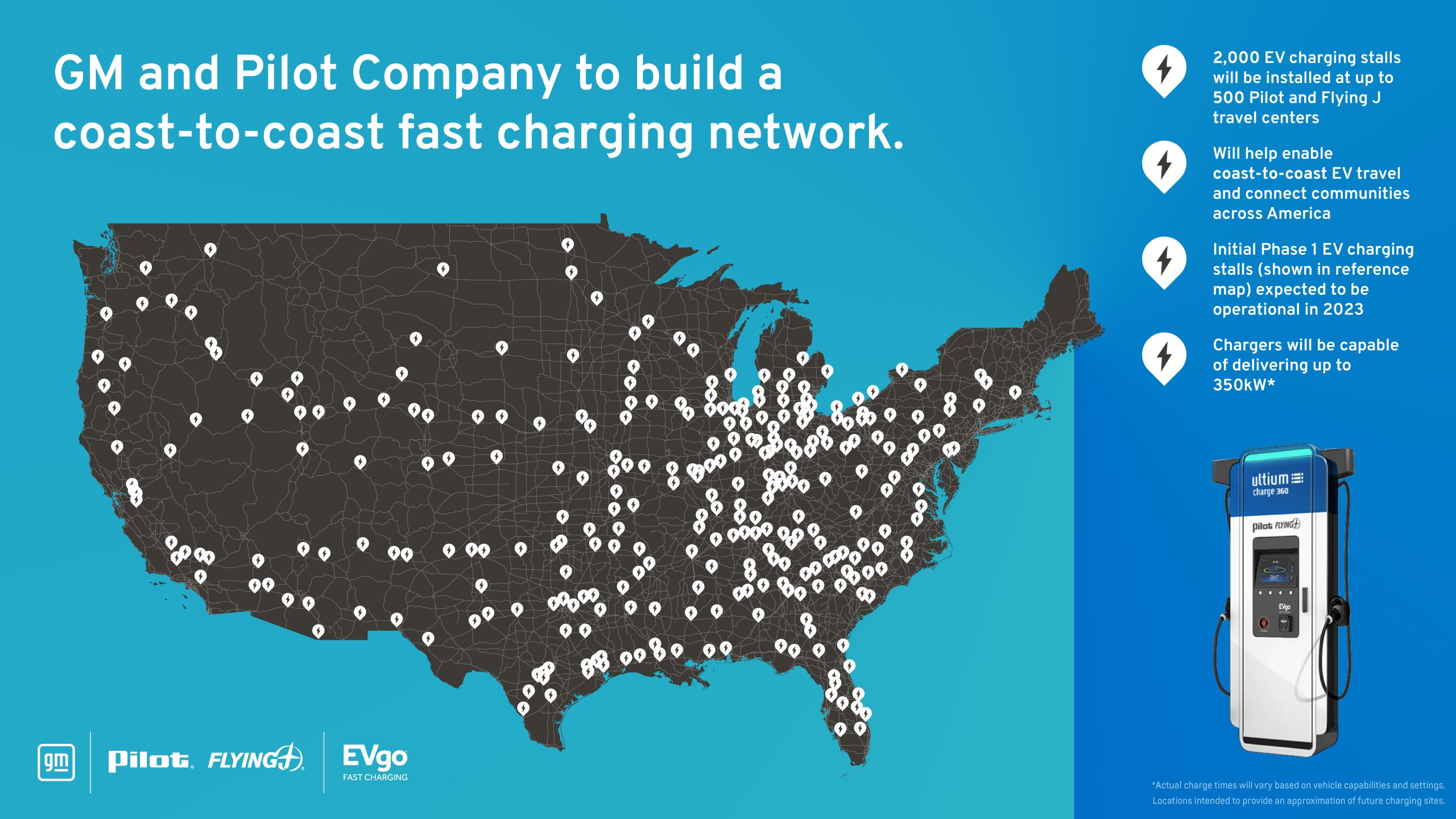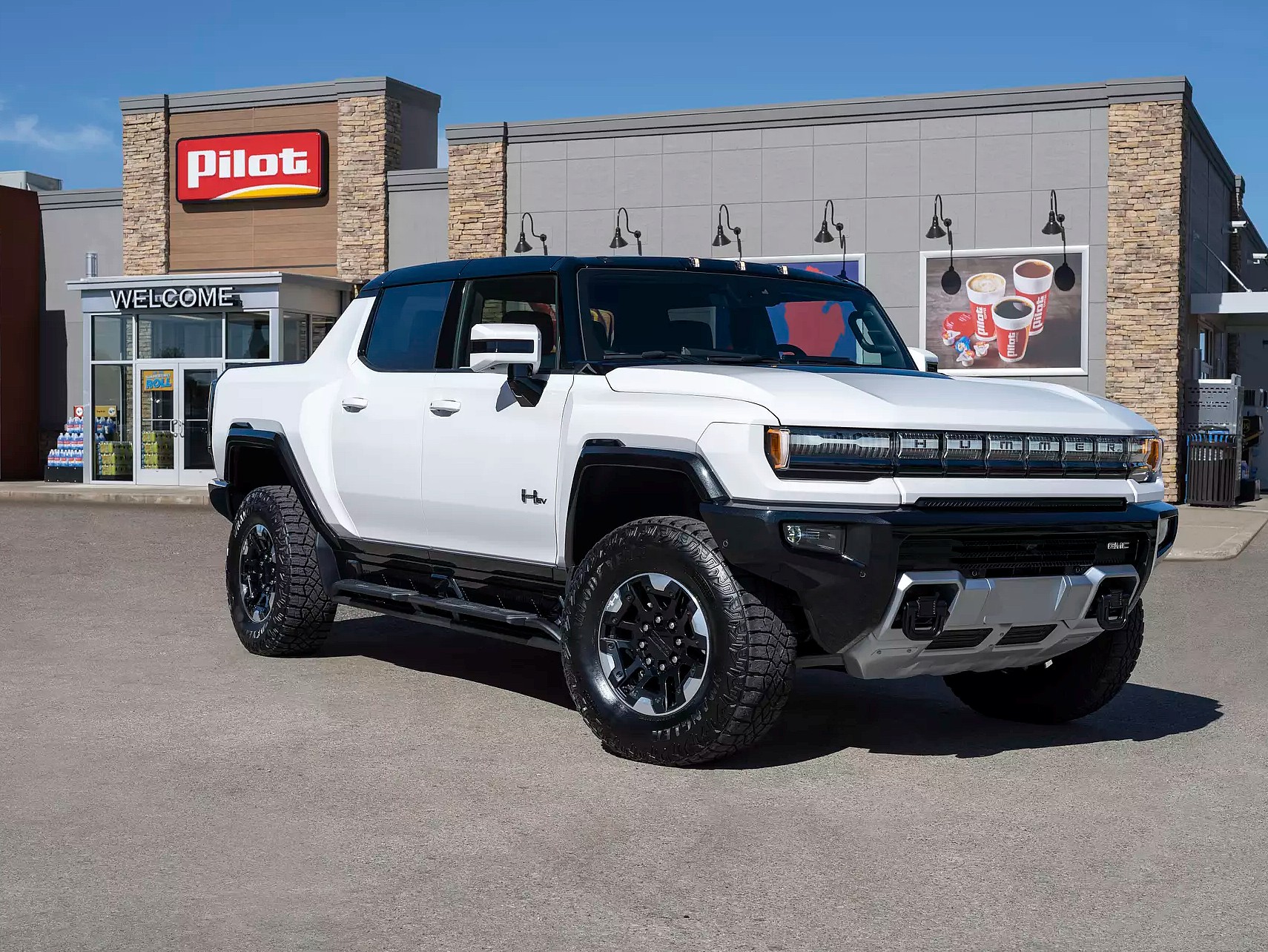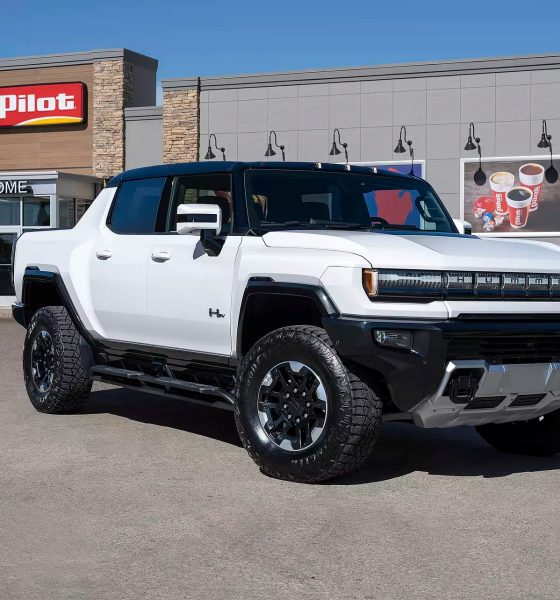General Motors will collaborate with Pilot Company (Pilot and Flying J) to establish a nationwide DC fast-charging network that will be installed, operated, and maintained by EVgo. The project is a demonstration of how public and private companies can help to build out the nationwide EV charging infrastructure, a crucial part of the expansion of electric vehicle adoption.
The 2,000-stall network will be built out along American highways, connecting urban and rural communities. Chargers will be available at 50-mile intervals across the United States.
The chargers will be open to all EV brands at up to 500 Pilot and Flying J locations, and GM customers, due to the collaboration, will receive exclusive benefits, including exclusive reservations, discounts on charging, real-time charger availability updates, and route planning. “This collaboration is expected to enhance America’s EV driving experience,” GM said.
The Pilot and Flying J locations that will be equipped with EVgo fast chargers will include numerous stalls, including ones capable of charging speeds up to 350 kW. EVgo is also working with GM to add more than 3,250 fast chargers to American cities and suburban areas within the next three years. EVgo was chosen due to its expertise in building, operating, and maintaining DC fast charging infrastructure. The sites will feature numerous convenience features as well, including pull-through capabilities for pickups and SUVs hauling trailers, and canopies to protect owners from weather and the elements.
GM’s Mary Barra said, “We are committed to an all-electric, zero-emissions future, and ensuring that the right charging infrastructure is in place is a key piece of the puzzle. With travel centers across North America, Pilot Company is an ideal collaborator to reach a broad audience of EV drivers.”

GM and Pilot Company to Build Out Coast-to-Coast EV Fast Charging Network
GM said that research performed by Escalent in 2021 showed one of the largest barriers to mass EV adoption was a lack of widespread access to highway charging, particularly in underserved urban and rural areas. This is a main reason for the collaboration, according to Cath Zoi, the CEO of EVgo.
“EVgo, GM, and Pilot Company share a commitment to building an electric fueling network that increases access and makes the shift to electrification as frictionless as possible for all. We look forward to this collaboration and ensuring the EVgo network provides nationwide coverage, including critical corridors for road trips, Zoi said. “Through EVgo eXtend, we are demonstrating yet another innovative pathway to help America electrify — and showcasing why EVgo’s technology and industry leadership make us the partner of choice to site hosts, automakers, and drivers alike as we work together to deliver a cleaner future of transportation.”
The collaboration is just one part of GM’s nearly $750 million investment into expanding the EV charging infrastructure:
- Enabling access to more than 100,000 charge points in the U.S. and Canada through its Ultium Charge 360 ecosystem
- Collaborating with EVgo to build out a network of 3,250 charging stalls in major metro areas by 2025
- Installing up to 40,000 chargers in local dealer communities through GM’s Dealer Community Charging Program, focusing on underserved rural and urban areas
On the other hand, the collaboration is also part of Pilot Company’s “New Horizons” initiative, which has set a $1 billion investment aside to fully upgrade travel centers with amenities and other features that are not typically available at current EV charging locations. These include free Wi-Fi, lounge areas, restrooms, on-site restaurants, coffee, travel essentials, and souvenirs.
I’d love to hear from you! If you have any comments, concerns, or questions, please email me at joey@teslarati.com. You can also reach me on Twitter @KlenderJoey, or if you have news tips, you can email us at tips@teslarati.com.

Elon Musk
Elon Musk and Tesla AI Director share insights after empty driver seat Robotaxi rides
The executives’ unoccupied tests hint at the rapid progress of Tesla’s unsupervised Robotaxi efforts.

Tesla CEO Elon Musk and AI Director Ashok Elluswamy celebrated Christmas Eve by sharing personal experiences with Robotaxi vehicles that had no safety monitor or occupant in the driver’s seat. Musk described the system’s “perfect driving” around Austin, while Elluswamy posted video from the back seat, calling it “an amazing experience.”
The executives’ unoccupied tests hint at the rapid progress of Tesla’s unsupervised Robotaxi efforts.
Elon and Ashok’s firsthand Robotaxi insights
Prior to Musk and the Tesla AI Director’s posts, sightings of unmanned Teslas navigating public roads were widely shared on social media. One such vehicle was spotted in Austin, Texas, which Elon Musk acknowleged by stating that “Testing is underway with no occupants in the car.”
Based on his Christmas Eve post, Musk seemed to have tested an unmanned Tesla himself. “A Tesla with no safety monitor in the car and me sitting in the passenger seat took me all around Austin on Sunday with perfect driving,” Musk wrote in his post.
Elluswamy responded with a 2-minute video showing himself in the rear of an unmanned Tesla. The video featured the vehicle’s empty front seats, as well as its smooth handling through real-world traffic. He captioned his video with the words, “It’s an amazing experience!”
Towards Unsupervised operations
During an xAI Hackathon earlier this month, Elon Musk mentioned that Tesla owed be removing Safety Monitors from its Robotaxis in Austin in just three weeks. “Unsupervised is pretty much solved at this point. So there will be Tesla Robotaxis operating in Austin with no one in them. Not even anyone in the passenger seat in about three weeks,” he said. Musk echoed similar estimates at the 2025 Annual Shareholder Meeting and the Q3 2025 earnings call.
Considering the insights that were posted Musk and Elluswamy, it does appear that Tesla is working hard towards operating its Robotaxis with no safety monitors. This is quite impressive considering that the service was launched just earlier this year.
Elon Musk
Starlink passes 9 million active customers just weeks after hitting 8 million
The milestone highlights the accelerating growth of Starlink, which has now been adding over 20,000 new users per day.

SpaceX’s Starlink satellite internet service has continued its rapid global expansion, surpassing 9 million active customers just weeks after crossing the 8 million mark.
The milestone highlights the accelerating growth of Starlink, which has now been adding over 20,000 new users per day.
9 million customers
In a post on X, SpaceX stated that Starlink now serves over 9 million active users across 155 countries, territories, and markets. The company reached 8 million customers in early November, meaning it added roughly 1 million subscribers in under seven weeks, or about 21,275 new users on average per day.
“Starlink is connecting more than 9M active customers with high-speed internet across 155 countries, territories, and many other markets,” Starlink wrote in a post on its official X account. SpaceX President Gwynne Shotwell also celebrated the milestone on X. “A huge thank you to all of our customers and congrats to the Starlink team for such an incredible product,” she wrote.
That growth rate reflects both rising demand for broadband in underserved regions and Starlink’s expanding satellite constellation, which now includes more than 9,000 low-Earth-orbit satellites designed to deliver high-speed, low-latency internet worldwide.
Starlink’s momentum
Starlink’s momentum has been building up. SpaceX reported 4.6 million Starlink customers in December 2024, followed by 7 million by August 2025, and 8 million customers in November. Independent data also suggests Starlink usage is rising sharply, with Cloudflare reporting that global web traffic from Starlink users more than doubled in 2025, as noted in an Insider report.
Starlink’s momentum is increasingly tied to SpaceX’s broader financial outlook. Elon Musk has said the satellite network is “by far” the company’s largest revenue driver, and reports suggest SpaceX may be positioning itself for an initial public offering as soon as next year, with valuations estimated as high as $1.5 trillion. Musk has also suggested in the past that Starlink could have its own IPO in the future.
News
NVIDIA Director of Robotics: Tesla FSD v14 is the first AI to pass the “Physical Turing Test”
After testing FSD v14, Fan stated that his experience with FSD felt magical at first, but it soon started to feel like a routine.

NVIDIA Director of Robotics Jim Fan has praised Tesla’s Full Self-Driving (Supervised) v14 as the first AI to pass what he described as a “Physical Turing Test.”
After testing FSD v14, Fan stated that his experience with FSD felt magical at first, but it soon started to feel like a routine. And just like smartphones today, removing it now would “actively hurt.”
Jim Fan’s hands-on FSD v14 impressions
Fan, a leading researcher in embodied AI who is currently solving Physical AI at NVIDIA and spearheading the company’s Project GR00T initiative, noted that he actually was late to the Tesla game. He was, however, one of the first to try out FSD v14.
“I was very late to own a Tesla but among the earliest to try out FSD v14. It’s perhaps the first time I experience an AI that passes the Physical Turing Test: after a long day at work, you press a button, lay back, and couldn’t tell if a neural net or a human drove you home,” Fan wrote in a post on X.
Fan added: “Despite knowing exactly how robot learning works, I still find it magical watching the steering wheel turn by itself. First it feels surreal, next it becomes routine. Then, like the smartphone, taking it away actively hurts. This is how humanity gets rewired and glued to god-like technologies.”
The Physical Turing Test
The original Turing Test was conceived by Alan Turing in 1950, and it was aimed at determining if a machine could exhibit behavior that is equivalent to or indistinguishable from a human. By focusing on text-based conversations, the original Turing Test set a high bar for natural language processing and machine learning.
This test has been passed by today’s large language models. However, the capability to converse in a humanlike manner is a completely different challenge from performing real-world problem-solving or physical interactions. Thus, Fan introduced the Physical Turing Test, which challenges AI systems to demonstrate intelligence through physical actions.
Based on Fan’s comments, Tesla has demonstrated these intelligent physical actions with FSD v14. Elon Musk agreed with the NVIDIA executive, stating in a post on X that with FSD v14, “you can sense the sentience maturing.” Musk also praised Tesla AI, calling it the best “real-world AI” today.










